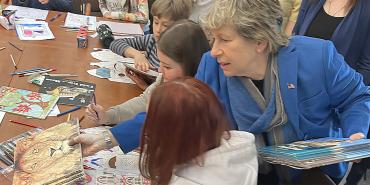When crisis strikes, teachers are there
It will surprise absolutely no one that I love being in schools. Since April 2021, I have visited more than 100 schools across the country, seeing how students and staff are overcoming the challenges created by the pandemic, and talking to them about what they need to recover and thrive. Last week, I went home, so to speak, to University Prep Charter School in the South Bronx, an outstanding public charter school that I helped establish with Steve Barr in 2009. Tragically, the visit was to mourn the shooting death of Angellyh Yambo, a beautiful, bright 16-year-old University Prep student who was caught in crossfire as she walked home from school.
I saw many expressions of grief—unstoppable tears, friends clinging to each other, and students walking somberly through quiet hallways that typically are pulsing with noise and activity. I also saw the earliest efforts to help students work through their loss and fears—from grief counselors to increased security in and around the school. I saw school staff huddled with students, setting aside their own grief to provide a steady presence amid the turmoil of students’ trauma and sorrow. Only days later, educators stepped into that role again after the horrendous shootings in a Brooklyn subway station just blocks from three public schools.
Teachers are frontline responders to students’ urgent needs—stemming not only from appallingly common gun violence, but from the ravages of poverty, which affects half of all public school students; the mental health crisis that predated COVID-19; and the social, emotional and academic impacts of the pandemic. Most teachers and support staff are not trained to be nurses, psychologists, mediators or magicians. But often, that’s what they are called on to do.
The relationships that educators build with students are like money in the bank. They can draw on them when students need encouragement, have disputes or experience loss, and sometimes they have to draw on them when students confront their own mortality, like after a shooting in a school or community or even after a drill to prepare for the possibility of one. When students have trusting relationships with teachers or other adults, they can express their fears—and share their dreams.
As a nation, we must respond to the need for more mental health professionals and social and emotional supports. President Joe Biden has stepped up. His 2023 budget includes $1 billion to help schools hire additional counselors, school psychologists and other health professionals to address the mental health crisis. We need more community schools, which connect students and families with health and social services, and more community behavioral health centers, so students and families can seek aid in their communities. Leaders must ensure that the mental health needs of educators are being met as they stand in the gap and try to ease the emotional burdens too many students carry. One way my union is doing this is by offering a free mental health benefit to our members.
Biden last week took another important step to reduce gun violence by banning unlicensed home kits to manufacture untraceable “ghost guns.” But much more must be done. Leaders could make communities safer from gun violence by taking commonsense steps: ban assault weapons, require background checks for all gun sales, make extreme risk protection orders available in every state, support local violence prevention and intervention programs, and enable research of gun violence as a public health issue.
But too many politicians have showed gutless indifference as tens of thousands of Americans die from gun-related injuries each year and the number of students who have experienced gun violence at school since the Columbine High School massacre exceeds 292,000.
Educators, on the other hand, will do what their heart and soul compel—connect, engage and protect their students.
I see this over and over again, at home and abroad. I saw the power of the relationships between students and teachers earlier this month at a school I visited on the Polish side of the Ukrainian border. Polish and Ukrainian teachers sang songs with young refugees and their mothers, who had left behind fathers and grandfathers to defend Ukraine. Children dipped their hands in paint the colors of the Ukrainian and Polish flags. One by one, they created a new flag with their handprints—blue, yellow, white and red—singing, smiling and simply being children, despite the turmoil in their lives. This is what teachers do: create relationships so powerful that they don’t have to be long-standing to be life-changing.

